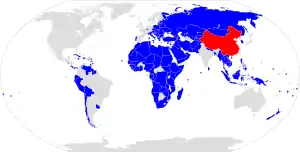Kunming–Singapore railway
The Kunming–Singapore railway, increasingly called the Pan-Asia railway Network[4] is a network of railways, being planned or under construction, that would connect China, Singapore and all the countries of mainland Southeast Asia. The concept originated with British and French imperialists, who sought to link the railways they had built in southwest China, Indochina and Malaya, but international conflicts in the 20th century kept regional railways fragmented. The idea was formally revived in October 2006 when 18 Asian and Eurasian countries signed the Trans-Asian railway Network Agreement, which designates the Kunming–Singapore railway as one of several planned trans-Asian railways.
| Kunming–Singapore railway | |
|---|---|
| Overview | |
| Status | Under Construction (Kunming-Vientiane, Nakhon Ratchasima-Bangkok),[1][2][3] Planned (Nakhon Ratchasima-Nong Khai), Cancelled (Kuala Lumpur-Singapore) |
| Locale | P.R. China, Myanmar, Thailand, Malaysia, Singapore |
| Termini | Kunming, China Singapore |
| Service | |
| Type | High-speed rail Heavy rail |
| History | |
| Planned opening | In phases 2021-2030 |
| Technical | |
| Line length | 3,900 km (2,400 mi) |
| Track gauge | 1,435 mm (4 ft 8 1⁄2 in) standard gauge 1,000 mm (3 ft 3 3⁄8 in) metre gauge |
| Electrification | 25 kV 50/60 Hz AC |
| Operating speed | 160–350 km/h (99–217 mph) |
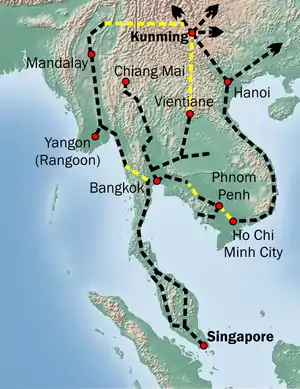
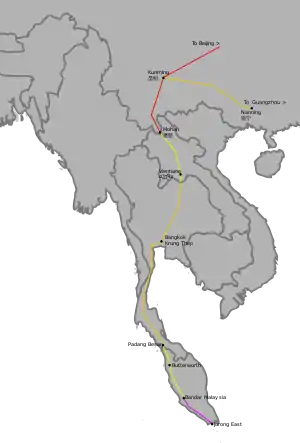
The proposed network consists of three main routes from Kunming, China to Bangkok, Thailand: the Eastern route via Vietnam and Cambodia; the central route via Laos, and the western route via Myanmar. The southern half of the network from Bangkok to Singapore has long been operational, though a high-speed line has been proposed.[5]
As of January 2014, construction of sections connecting China with Vietnam, China with Myanmar and Laos with Vietnam are under way. Work on sections in Laos began in December 2017 and is expected to be completed in 2021 with Chinese assistance.[6] The railway network is expected to increase regional economic integration and increase China's economic ties with Southeast Asia.[7][8] A high-speed rail project in Vietnam with Japanese support was canceled in 2010 due to high cost. However, it will be re-considered during 2019 communist party session, as Vietnam's economy is growing at much faster pace than anticipated.
History
Colonial railways
The British and French Empires first proposed building a railway from Kunming to Singapore in 1900 as Russia was completing the Trans-Siberian railway.[9] From 1904 to 1910, the French built the Yunnan–Vietnam railway, to connect Kunming with Hanoi and Haiphong in French Tonkin, now northern Vietnam.
In 1918, the southern line of the Thailand railway system was connected with British Malaya's west coast line, completing a metre gauge rail link from Bangkok to Singapore.[10] In the late-1930s, the British began to build the Yunnan–Burma railway but abandoned the effort in 1941 with the outbreak of World War II.
In 1936, Vietnam's main railway, from Hanoi to Saigon was completed. This French-built system was (and still is) metre-gauge.
In 1942, the railways of Thailand and Cambodia were connected linking Bangkok and Phnom Penh, but this trans-border connection has long since fallen into disuse. The Japanese Empire built the infamous Thailand–Burma railway using prisoners of war to connect Bangkok and Yangon, but the entire line never entered commercial operation and is now partially submerged by the reservoir behind the Vajiralongkorn Dam.
A continuous metre-gauge rail line from Kunming to Singapore via Hanoi, Saigon, Phnom Penh, Bangkok, and Kuala Lumpur was not realized as the French never built the "missing link" between Phnom Penh and Saigon, choosing to build a highway instead.[11]
21st century revival
In 2000, ASEAN proposed completing the Kunming to Singapore railway, via Hanoi, Ho Chi Minh City (formerly Saigon), Phnom Penh, and Bangkok.[9][12][13] This 5,500 km (3,400 mi) route is now known as the eastern route. In 2004, ASEAN and China proposed the shorter western route, which instead of running east through Vietnam and Cambodia, would go west from Kunming to Myanmar and then to Bangkok.[14] In 2007 ASEAN and China proposed building three routes, the Eastern, Western and a central route via Laos.[15]
Planning & Construction
Eastern route
- In China
- Kunming–Hai Phong railway (Kunming-Hekou section), 465 km old metre gauge railway from Kunming to the Hekou Yao Autonomous County on the border with Vietnam (completed in 1910).
- Kunming–Yuxi–Hekou railway, 370 km (230 mi) standard gauge railway from Kunming to Hekou (via Yuxi and Mengzi, completed in 2014).
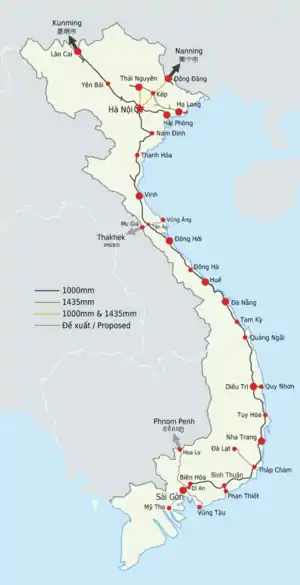
- In Vietnam
- Kunming–Haiphong railway (Lao Cai-Haiphong section), metre gauge railway from Lao Cai, on the border with China, to Haiphong via Hanoi (completed in 1910).
- North–South railway of Vietnam, metre gauge railway from Hanoi to Ho Chi Minh City (completed in 1936).
- North–South express railway of Vietnam, 1,570 km (980 mi) standard gauge, high-speed rail, from Hanoi to Ho Chi Minh City (cancelled). This line was jointly planned by Vietnam and Japan using Shinkansen bullet train technology and financed in part by Japanese official development assistance. The project was scheduled to be built in stages from 2011 to 2020. In June 2010, Vietnam's National Assembly rejected the plan due to high construction cost, reportedly equal to about 50 percent of the country's GDP. However, the project will be re-considered during 2019 Vietnam's National Assembly Session as Vietnam's economy is growing much faster, thus significantly decreasing the project's cost / GDP ratio.
- In Laos
- Savannakhet–Lao Bao railway, a 220 km (140 mi), electrified double track, high-speed railway from Savannakhet in Savannakhet Province, on the Thai border, to Lao Bảo in Vietnam's Quảng Trị Province. The project costs US$4 billion and is being built by the Giant Consolidated of Malaysia.[16] A ground breaking ceremony was held in Ban Naxai on December 18, 2013.[17] This line will also be extended to the port city of Danang in Vietnam, and give landlocked Laos an outlet to the South China Sea.[17]
- In Cambodia
- The Phnom Penh to Poipet railway, next to Aranyaprathet on the Thai border, was rebuilt and reopened on July 5, 2018. The original railway was destroyed in 1973 during the Cambodian Civil War.[18]
- The disconnected rail link from Phnom Penh to Ho Chi Minh City is being reconsidered. The cost for construction is estimated around US$600 million and the Chinese government will fund most proportion of construction. The Cambodian government will deal with the relocation of people who will be affected by the proposed new railway construction. The section from Phnom Penh to the Thai border
Central route
The central route including the Bangkok to Singapore section will be 3,900 km (2,400 mi) in length.[7] A trip from Kunming to Singapore will take 30 hours in 2022, and 18 hours when completed in 2040. (compared to 80 hours from Vientiane to Singapore in January 2019).[19][20] The line will be used to transport both passengers and cargo.[8][21]
The central route consists of the following sections:
In China
- Kunming–Yuxi railway, from Kunming to Yuxi (completed in 1993, upgraded in 2016).
- Yuxi–Mohan railway, 503 km standard gauge railway from Yuxi to Mohan at the border with Laos (under planning). This line was originally planned to begin construction by the end of 2010, but has been delayed. Construction of a railway logistics hub in Mohan began in early 2011.[22] Construction began in 2016 and schedule for completion in 2022 from Yuxi-Jinhong-Mohan.
In Laos
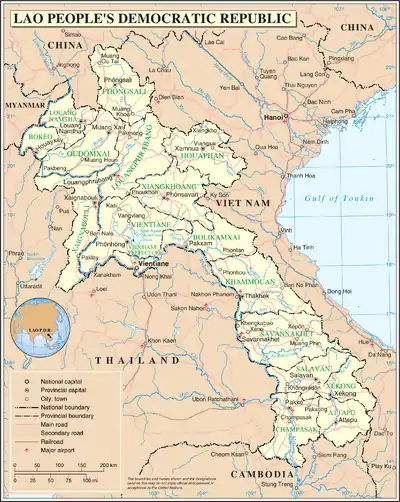
- Boten-Vientiane railway, 421 km (262 mi) standard gauge line from Boten in Luang Namtha Province on the border with China, to Thanaleng, on the border with Thailand. This section is to be opened in late 2021.[4][23]
This line was originally planned as a high-speed rail joint-venture between the Laotian government and the China Railway Corporation, the Chinese state rail operator, and set to begin construction on 25 April 2011 but was delayed due to a corruption scandal that removed the Chinese railway minister, Liu Zhijun from office.[7] The Laotian government then became the sole investor in the project, which is funded with a loan from the Export-Import Bank of China that would cover 70 percent of the project's cost of US$7 billion.[24][25][26] The project was downgraded to a conventional speed railway with a maximum speed of 160 km/h instead of 200 km/h.[25] As the terrain in Laos is mountainous, 76 bridges and 154 tunnels will need to be built.[25] Unexploded bombs that have been dropped during the Vietnam War will have to be removed.[8][22]
The loan finance arrangement for this line was criticized by economists in the West as too expensive for Laos.[27] There is also controversy over villagers whose houses will be moved to accommodate the new railway line. One village, Bopiat in northern Laos, has already been moved once to allow the construction of a casino.[26][28] The National Assembly of Laos approved the project in October 2012, but the construction has not commenced because the Chinese state lender has been waiting since July 2013 for the Thai legislature to approve funding for the Thailand section of the railway line. On 22 July 2014, China's Exim Bank suspended loans to Laotian infrastructure projects, leaving the rail project in jeopardy.[29] On 28 July 2014, at a meeting with Chinese Communist Party general secretary Xi Jinping in Beijing, Lao People's Revolutionary Party general secretary Choummaly Sayasone asked the Chinese government to continue its assistance of rail development in Laos.[30]
In October 2014, Radio Free Asia reported that China had made a new pledge to finance the project as talks between the two countries continued.[31]
In January 2016, Singapore's Straits Times reported that ground was broken on the project in December 2015.[32]
Existing
- Northeastern Line (Thailand), a metre gauge railway connecting Bangkok with Nong Khai. Currently in operation.
- Southern Line (Thailand), a metre gauge railway connecting Bangkok with Hat Yai / Sungai Kolok. Currently in operation.
- Hat Yai - Padang Besar Shuttle Train
Planned / Under Construction
- Bangkok-Nong Khai High Speed Railway, a high-speed railway from Bangkok to Nong Khai on the border with Laos. As of 2020, 2 of the contracts for the Bangkok-Nakhon Ratchasima section is under construction, while the Nakhon Ratchasima - Nong Khai have yet to enter the bidding phase. Costs of this section was to be determined by February 2016 with construction starting in May 2016. When completed, eight-car, 613 passenger CRH2G[33] passenger trains will run on the line at a maximum speed of 250 km/h. At a speed of 180 km/h, it is estimated that passenger trains will run from Bangkok to Nong Khai in 230 minutes. HXD3B and HXD3C electric locomotives will be used to power freight trains travelling the line at 120 km/h.[4]
- Bangkok-Hat Yai / Padang Besar railway, a high-speed railway from Bangkok to Hat Yai and Padang Besar, near the border with Malaysia (under planning).

Planning for these lines began during the administration of Prime Minister Abhisit Vejjajiva of the Democratic Party, which agreed to borrow US$400 million from China to purchase materials and expertise, and build one high speed line to Nong Khai Province to the north and another to the Padang Basar on the Malaysian border to the south.[34] When Prime Minister Yingluck Shinawatra of the Puea Thai Party took office in August 2011, the Thai government initially scaled back those plans and proposed shorter lines that connected Thai cities but did not reach international frontiers.[34] Supoj Sablorm, the secretary of the Thai Ministry of Transport, explained that Thailand was not in a rush to build a high-speed rail line to Laos because the Chinese-backed project in Laos had been delayed to beyond 2014.[34] A year later in August 2012, the Thai government announced the plans to build four high-speed rail lines, including extensions to Nong Khai and Hat Yai by 2022.[35] In October 2013, Chinese Premier Li Keqiang, on a visit to Thailand, promoted Chinese high-speed rail technology and offered loan packages for high-speed rail construction that are partially repayable with rice and rubber.[36]
On 19 November 2013, the Thai Senate passed a bill that authorized the government to borrow US$69.5 billion to fund high-speed rail and other infrastructure projects in Thailand without going through the annual government budgeting process.[37] The opposition Democratic Party challenged the spending bill in court and a judge expressed doubt about the necessity of high-speed rail for Thailand.[38] The ensuing political protests in Bangkok, which began in December 2013 and continued through May 2014, has paralyzed the Thai government and prevented further decision-making of the rail project.
On 30 July 2014, Thai army chief General Prayut Chan-o-cha, whose forces seized control of the government through a bloodless coup in May, announced plans to build two high-speed rail lines as part of a 741.4 billion baht transportation program.[39] The Nong Khai to Map Ta Phut line, 737 kilometres (458 mi) in length, would run from the Laotian border at Thanaleng to the Gulf of Thailand.[39] The Chiang Khong to Ban Phachi line, 655 kilometres (407 mi) in length, would run from Chiang Rai near the northern tip of Thailand to Ayutthaya just north of Bangkok.[39] The two lines would allow trains to travel at a top speed of 160 km/h.[39] Construction is scheduled to begin in 2015 and is to be completed in 2021.[39]
In November 2014, after a meeting between Li Keqiang and Prayut Chan-o-cha, China agreed to lend Thailand funds to build dual-track standard gauge mid-speed railways on the Bangkok-Nong Khai, Bangkok-Map Ta Phut, and Kaeng Khoi–Map Ta Phut routes.[40] The loans could be repaid with rice and rubber.[40] On 4 December 2014, the Thai National Legislative Assembly voted 187–0 with seven abstensions to approve loans for the Nong Khai-Map Ta Phut and Kaeng Khoi-Bangkok lines.[41] China would undertake construction and development of the lines but would not receive land use rights along the routes.[41] On 19 December 2014, the two countries signed a memorandum to build the railways.[42]
As of December 2015, China and Thailand have agreed to build the 845 km double-track rail routes connecting Bangkok-Kaeng Khoi-Nakhon Ratchasima-Khon Kaen-Udon Thani-Nong Khai and a second section connecting Kaeng Khoi-Map Ta Phut. The two parties have not yet reached agreement on financing for the project.[4]
In March 2020, the Thai government committed to a US$21 billion railway expansion plan that will include a high speed rail from China to Singapore through Bangkok via the Laotian border near Vientiane.[43]
Western route
The western route consists of the following railway sections:
In China
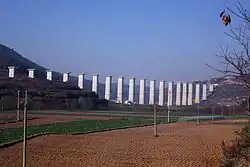
- Chengdu–Kunming railway, 115 km (71 mi) from Kunming to Guangtong (completed in 1971)
- Guangtong–Dali railway, 213 km (132 mi) from Guangtong to Dali (completed in 1998), and
- Dali–Ruili railway, 336 km (209 mi) from Dali to Ruili on the border with Myanmar (under construction since 2011).
In Myanmar
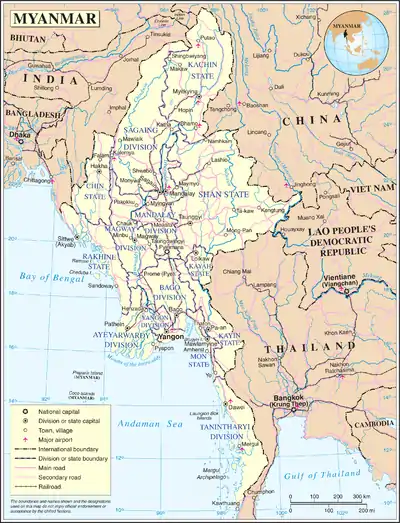
- Kunming–Yangon high-speed railway (Myanmar section), from Muse in the Shan State on the border with China to Yangon with maximum train speeds of 170–200 km/h.
The Kunming–Yangon high-speed railway forms a portion of the 1,215 km (755 mi) high-speed railway from Kunming to Rakhine State on the Bay of Bengal.[44]
In the summer of 2018, it seems plans are again on to complete the China-Myanmar railway. [45] In late November 2010, Chinese state media reported that the railway would begin construction in about two months.[46] But in March 2011, the Chinese Commerce Minister Chen Deming stated that the project was delayed due to the first elections in Myanmar in 20 years and differences in the railway gauge of the two countries.[47] He explained the Chinese rail developers were waiting for the new cabinet in Myanmar to form and expressed hope that work on the line would begin before the end of 2011.[47]
On 18 July 2014, the Myanmar government cancelled the project, citing opposition from civil rights groups, villagers and the general public.[44]
- Yangon–Myitkyina railway, from Yangon to Myitkyina, near the border with China (existing railway).
In December 2013, the Myanmar government began to discuss the upgrade of the existing Yangon-Myitkyina railway with the Asian Development Bank and the government of South Korea.[48]
- Yangon–Mandalay railway, from Yangon to Mandalay (existing railway).
In December 2013, Japanese media reported that the Myanmar and Japanese governments had reached an agreement to upgrade this line.[48]
- Yangon–Bangkok railway.
In May 2012, the railway Minister Aung Min of Myanmar announced that a feasibility study would be undertaken to rebuild the 105-km stretch of the Thai–Burma railway from the Three Pagoda Pass to the Thai border.[49] The railway could be reopened, he said, with international assistance and promote development in the region and peace with ethnic Shan and Karen rebels in the border areas.[49]
Malaysia to Singapore section
The existing route uses the KTM ETS tracks from Padang Besar to Gemas and southwards using diesel trainsets on a single track to Woodlands Train Checkpoint, Singapore. The line from Padang Besar to Gemas was electrified and double tracked in 2015, and upgrade works from Gemas to Johor Bahru are expected to be completed in 2021, bringing down journey times from Woodlands North in Singapore to KL Sentral to about 4 hours, via Bukit Chagar.[50]
In 2013, the governments of Malaysia and Singapore agreed to build a Kuala Lumpur-Singapore High Speed Rail from Kuala Lumpur to Singapore that was scheduled to open in 2026. But shortly after winning the May 2018 election, the incoming Malaysian prime minister, Mahathir Mohamad said he would reconsider the project.[51][5] Among revisions being explored to reduce costs, was to align the route to the existing meter gauge Keretapi Tanah Melayu (KTM) line and lay a standard gauge track in parallel, with a fork running to Jurong East so that bilateral agreement is not violated, to allow trains running at 200 km/h, cutting journey time between Kuala Lumpur and Singapore to 130 minutes.[52] Stations were planned for Bandar Malaysia in Kuala Lumpur, Bangi-Putrajaya, Labu (Seremban), Muar, Batu Pahat, Iskandar Puteri and Jurong East. The plan has been cancelled after 2 extensions requested by Malaysia, with the project allowed to lapse on 31 December 2020.[53]
According to PLANMalaysia, the northern high-speed rail corridor will be built along North-South Expressway and the stations will be at Tanjung Malim, Tapah, Ipoh, Taiping and terminated at Butterworth.[54]
See also
- High Speed Rail
- Trans-Asian Railway
- High Speed Rail in China
- Kuala Lumpur–Singapore high-speed rail
References
- https://www.railwaygazette.com/news/infrastructure/single-view/view/construction-starts-on-china-laos-railway.html
- https://www.straitstimes.com/asia/se-asia/ground-broken-for-thailand-china-railway-project-after-delays
- https://www.channelnewsasia.com/news/asia/high-speed-rail-postponed-malaysia-singapore-agreement-10686032
- Mahitthirook, Amornrat (2015-12-28). "Bangkok set to be China's rail hub". Bangkok Post. Retrieved 30 December 2015.
- "KL mulls Penang-Singapore high-speed rail link". The Malaysian Insisder. 21 September 2010. Retrieved 26 April 2011.
- {{|url= http://www.xinhuanet.com/english/2018-07/10/c_137315177.htm}}
- "Kunming-Singapore High-Speed railway begins construction". People's Daily. 25 April 2011. Retrieved 26 April 2011.
- "China coming down the tracks". The Economist. 20 January 2011. Retrieved 26 April 2011.
- "SE-Asia railway idea revived". BBC. 4 November 2001. Retrieved 26 April 2011.
- Kakizaki, Ichirō (2005), Laying the tracks: the Thai economy and its railways 1885-1935, Volume 10 of Kyoto area studies on Asia, Trans Pacific Press, p. 113, ISBN 1-920901-02-7
- Kakizaki 2005, p. 127
- "The Singapore-Kunming rail link project" (PDF). ASEAN. 26 September 2007. Retrieved 26 April 2011.
- "Kunming Singapore railway". Philippine Daily Enquirer. 23 November 2000. Retrieved 26 April 2011.
- "Asean signs historic deal with China". The Guardian. 29 November 2004. Retrieved 26 April 2011.
- "Wen: China to speed up Pan-Asian rail link". China Daily. 15 January 2007. Retrieved 26 April 2011.
- "Laos signs railway project to link with Vietnam". China Daily. 2012-11-06. Retrieved 2014-02-19.
- "Laos Breaks Ground On railway Project Linking Thailand to Vietnam". Radio Free Asia. 2014-01-03. Retrieved 2014-02-19.
- "Cambodia restores rail link to Thailand border after 45 years". South China Morning Post. 5 July 2018. Retrieved 10 August 2018.
- "Train schedules for the main line between Singapore, Malaysia & Thailand..." Seat61. Retrieved 26 April 2011.
It's up to you whether you travel from Singapore to Bangkok all in one go in 48 hours
- "Bangkok to Vientiane by train..." Seat61. Retrieved 26 April 2011.
- "Work Begins on Kunming-Singapore High-Speed Rail Link". Voice of America. 25 April 2011. Retrieved 26 April 2011.
- "Work begins on Kunming to Singapore high-speed railway". Eandt.theiet.org. 2011-05-16. Archived from the original on 2014-02-21. Retrieved 2014-02-13.
- "China-Laos railway project set to be complete by late 2021". People's Daily. 20 November 2017.
- "Work begins on Kunming-Singapore rail link". Want China Times. 2011-04-25. Archived from the original on 23 February 2014. Retrieved 19 February 2014.
- "Vientiane-China rail link now a priority project". Deutsche Presse-Agentur. 25 September 2013. Retrieved 19 February 2014.
- "Train plan upsets Lao villagers". TR Weekly (AFP). 11 April 2011. Retrieved 26 April 2011.
- "China's 120mph railway arriving in Laos China's mammoth engineering project to construct a railway from southwest China's Yunnan Province all the way to Singapore is set to transform rural Laos". The Telegraph. 2014-01-14. Retrieved 2014-02-19.
- "Upheaval along the tracks for Laos villagers". AFP. 11 April 2011. Retrieved 26 April 2011.
- "China's EximBank Suspends Loans For Roads, Bridges in Laos" Radio Free Asia 2014-07-22
- "Xi Jinping Holds Talks with Choummaly Saygnasone, General Secretary of the Central Committee of the Lao People's Revolutionary Party (LPRP) and President of Laos" PRC Foreign Ministry 2014-07-28
- "China Gives New Pledge on Lao Rail Project" RFA 2014-10-06
- "China's dream of rail link to S-E Asia coming true". 21 January 2016.
- Barrow, Keith (2015-11-13). "Chinese 'Alpine' high-speed train to enter service next month". International railway Journal (IRJ). Retrieved 30 December 2015.
- "Thailand revises high-speed rail plan, Laos link shelved". Reuters. Reuters. 2011-08-23. Retrieved 2014-02-19.
- Nophakhun Limsamarnphun (2012-08-18). "High-speed rail network to link Asean countries". The Nation. Retrieved 2014-02-19.
- "China still has chance to be part of Thailand rail project". 2014-02-19. Archived from the original on 22 December 2014. Retrieved 19 February 2014.
- "Thai Senate passes $69.5B infrastructure bill". 2013-11-19. Retrieved 19 February 2014.
- "Constitution Court Judge: High speed rail not necessary for Thailand". 2014-01-09. Retrieved 19 February 2014.
- Amornrat Mahitthirook, "High-speed train gets go ahead – Two routes okayed in B741bn scheme" Bangkok Post 2014-07-30
- "Dual-track trains to get China loan. Beijing to be repaid in Thai rice and rubber." Bangkok Post 2014-11-02
- "NLA OKs Thai-China rail deal" Bangkok Post 2014-12-04
- Patsara Jikkham & Chatrudee Theparat, "Prayut, Li strike railway accord PM to visit China for inking of 4 more deals." Bangkok Post 2014-12-20
- "Thailand looks to clear Bangkok's polluted skies with giant railway linking China, Singapore". The Straits Times. March 1, 2020.
- "Stalled $20bn Arno Maierbrugger, "Myanmar railway project a setback for Asia-Mideast trade" Gulf Times 2014-07-28
- https://www.mmtimes.com/news/china-myanmar-high-speed-railway-quietly-back-track.html
- "High-speed rail between Yunnan and Myanmar on agenda". People's Daily=2010-11-22. Retrieved 2014-02-19.
- "中缅高铁被迫暂缓施工". Duowei News=2011-03-08. Archived from the original on 2013-08-14. Retrieved 2014-02-19.
- "Myanmar govt looking to upgrade Yangon-Myitkyina Rail railway". Thai PBS. 2013-12-12. Archived from the original on 2014-02-23. Retrieved 2014-02-19.
- "Burma to restore infamous Death railway". ABC.net.au. 2012-05-21. Retrieved 2014-02-19.
- https://www.thesundaily.my/archive/gemas-jb-electric-double-tracking-project-can-increase-development-renggam-maszlee-IUARCH586958
- https://www.ft.com/content/c7975d7c-6243-11e8-90c2-9563a0613e56
- "Report: KL-Singapore rail link could be RM50b cheaper | Malay Mail". www.malaymail.com. Archived from the original on 19 June 2018. Retrieved 19 June 2018.
- https://www.thestar.com.my/news/nation/2021/01/01/malaysia-singapore-terminate-hsr-project
- National Physical Plan 3, 2017, PLANMalaysia
